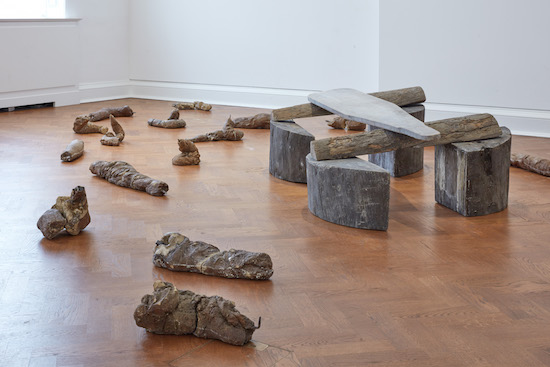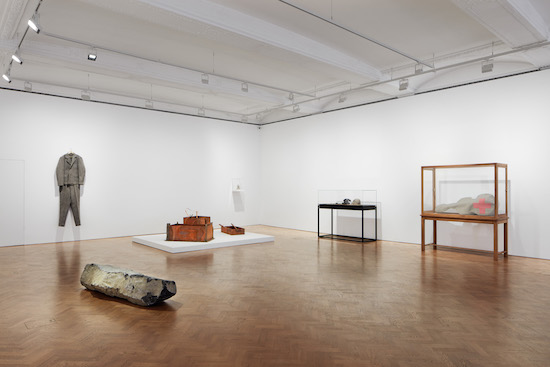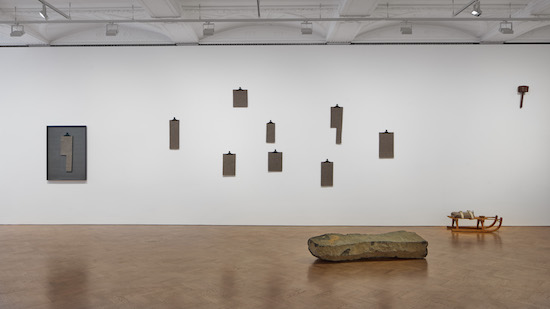Images: Courtesy Galerie Thaddaeus Ropac, London–Paris–Salzburg. Photo: Tom Carter
There are maybe two stages, quite distinct: you walk into the gallery, and in the centre of the room, beyond the thin white rope marking the borderline between the work and its audience, you see an arrangement of wood.
That’s probably all it is, to begin with. Some wood, arranged. Or not arranged, perhaps – could it be merely slung? It’s hard to tell.
And yet, somehow, you find yourself drawn in. There’s something compelling. Hard to pinpoint. Just…
The pieces themselves are dark grey and deeply weathered. They look as if they’ve been formed more by nature, by the gradual processes of erosion and abrasion that befalls driftwood, left out, exposed to the elements. Stuff of the land, not of a carpenter.
There are four vaguely plinth-like, roughly semi-circular hunks with two logs forming a bar against each pair and another plank – flat, rather like the outline of a wine bottle – joining these.
The whole ensemble has a certain shape, a deliberate arrangement, sure, ok, a kind of homespun geometry. But it speaks, mostly, of age and death and eternal process, of something ancient and primeval.
Surrounding it, scattered across the floor: thirty-eight little mishapen lumps of brown clay, frankly turd-like in shape and appearance. Low forms, in every sense. The whole thing is a mess, a kind of dirty protest. An archipelago of excrescence.
Then you glance at the list of works on a sheet of paper in your hands or at the neatly printed wall text by the side, there to identify, specify, and legitimate the work before you. “Hirsch (Stag)” it says, indicating the arrangement of wood (which, further, is identified as teak; the central plank as the artist’s mother’s old ironing board). “Urtiere (Primordial Animals)” it nods to the excrecent lumps.
You look again. Something starts to change. A spark of life leaps into the room.

The story goes like this: In 1982, Norman Rosenthal, then director of the Royal Academy, and the Greek art historian Christos M. Joachimides were putting together what would become one of the era’s most important exhibitions of painting. Martin Gropius Bau, one-time Prussian museum of applied arts, dating back to the 1870s. The centre of Berlin.
The other invited artists ncluded Frank Stella, David Salle, Pier Paolo Calzolari, Cy Twombly, Georg Baselitz, Francesco Clemente, Susan Rothernberg. The show is called Zeitgeist and it did a pretty good job of living up to it.
Beuys is given the atrium of the building, the very centre-piece of this dazzling paint-spattered pièce montée. Beuys simply emptied the contents of his studio into the space and slathered it in wet clay. Workbenches, tools, everything remains.
Later, it would be cast in bronze – renamed Blitzschlag mit Lichtschein auf Hirsch (Lightning with Stag in its Glare), (1958–85). In this form it would be purchased by the Tate, placed on permament exhibition. But for now, everything remains tentative, precarious, deliberately – almost performatively – unfinished. A flashbulb capturing the act of creation in process. Exposed and developed, but never quite fixed and dried.
A young Thaddaeus Ropac, then just a twenty-two year-old aspiring artist had recently travelled to Düsseldorf to meet Beuys. Somehow he ended up as a sort of intern “basically being around and carrying the beer”, as he admitted to the FT’s Melanie Gerlis recently. He started working with Beuys just in time for the Zeitgeist show. “I didn’t understand Beuys back then,” Ropac said. “Art was traditionally about painting and here was an artist discussing how best to glue earth together while also talking about philosophy. He was so charismatic, although, I could feel he was a towering influence.”
Three and a half decades later, Ropac’s gallery now represents Beuys’ estate. The present show is the first manifestation of that relationship. It is the first time these scattered Stage Monuments have been reunited in a single room since that show at the start of the 80s. Their peculiar alchemy remains undimmed.

Beuys’ works have a tendency to look more found then formed, as if dug up somewhere. Unearthed – and then, perhaps, only partially. But image if you found such things while tarrying in some archaeological dig. What strange and wondrous prehistoric magicians would these artefacts bear witness to?
The small, early bronze work Hirschkuh mit Jungem (Doe with Calf), (1948), a fleet etching of animal forms on a cracked and burnished shard, looks more like something out of the Chauvet Caves tha the Tate Modern. Junges Pferdchen (Young Horse), (1955–1986), gives us, in a wooden framed vitrine, not just the wax sculpture of a horse, more-or-less lifelike albeit now crumbly and mildewed, but also the clay mould in which it was cast, now split open, its fragments splayed about the case.
What Beuys is interested in, above all, is the act of creation itself. See his Ofen (1950) mit Torso (1948), a concrete kiln with a woman’s body emerging from its chimney. This moment of alchemy, spark of creation. The only question is: where does this power reside? In the hand that forms or the eye that looks?
Joseph Beuys, Utopia at the Stag Monuments, is at Thaddaeus Ropac, London, until 16 June


